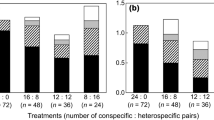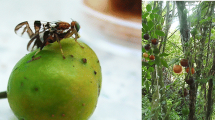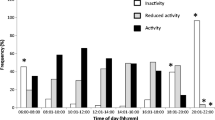Abstract
Rhagoletis zoqui Bush flies have a mating system in which males guard and defend walnut fruit-hosts from other males and mate, apparently without courtship, with females as they arrive to oviposit. Hypothetically, female selection of a particular fruit may be due to the quality of fruit for larval development (previously determined by guarding males), the quality of the male upon the fruit as a mate, or both, but this is not clear. We performed an experiment to determine if R. zoqui females or males select the fruit to oviposit or guard based on its quality for larval development (i.e., size, sugar-content [brix] or hardness), or following male-mediated cues such as chemical residues, related to prior fruit occupation by the male during guarding. Fruit choice by R. zoqui females and males were examined under semi-natural conditions on caged branches of English walnut trees, Juglans regia L., growing in the highlands of south-central Mexico. A single male or female was allowed to select a fruit and was then removed. An individual of the opposite sex was then introduced to the same branch and presented with the opportunity to choose among the same array of hosts. The pattern of fruit choice was consistent, with female choice on the basis of male presence, suggesting that males left a chemical cue that persisted in their absence. No fruit quality differences were detected between selected and non-selected fruit. Fruit features selected by females and males matched almost exactly, although males rarely select the same fruit as females. We conclude that females preferentially selected fruit previously occupied by males although additional studies are required to determine the cues used by R. zoqui for oviposition resource selection by both females and resource guarding males.



Similar content being viewed by others
References
Alcock J, Thornhill R (2014) The evolution of insect mating systems. In: DM Shuker, LW Simmons (eds) The Evolution of Insect Mating Systems. Oxford University Press, USA, pp 275–278
Alonso-Pimentel H, Korer J, Nufio C, Papaj D (1998) Role of colour and shape stimuli in host-enhanced oogenesis in the walnut fly, Rhagoletis juglandis. Physiol Entomol 23:97–104
Aluja M, Mangan RL (2008) Fruit fly (Diptera: Tephritidae) host status determination: critical conceptual, methodological, and regulatory considerations. Annu Rev Entomol 53:473–502
Aluja M, Piñero J, López M, Ruíz C, Zúñiga A, Piedra E, Díaz-Fleischer F, Sivinski J (2000) New host plant and distribution records in Mexico for Anastrepha spp., Toxotrypana curvicauda Gerstacker, Rhagoletis zoqui Bush, Rhagoletis sp., and Hexachaeta sp. (Diptera: Tephritidae). P Entomol Soc Wash 102:802–815
Aluja M, Lozada N, Piñero J, Birke A, Hernández- Ortíz V, Díaz-Fleischer F (2001) Basic behavior of Rhagoletis turpiniae (Diptera: Tephritidae) with comparative notes on the sexual behavior of Rhagoletis pomonella and Rhagoletis zoqui. Annals Entomol Soc Am 94: 268–274
Aluja M, Rull J, Sivinski J, Trujillo G, Perez-Staples D (2009) Male and female condition influence mating performance and sexual receptivity in two tropical fruit flies (Diptera: Tephritidae) with contrasting life histories. J Insect Physiol 55:1091–1098
Andersson MB (1994) Sexual selection. Princeton, New Jersey. Princeton University Press
Arnqvist G, Nilsson T (2000) The evolution of polyandry: multiple mating and female fitness in insects. Animal Behav 60:145–164
Balagawi S, Vijaysegaran S, Drew RAI, Raghu S (2005) Influence of fruit traits on oviposition preference and offspring performance of Bactrocera tryoni (Froggatt) (Diptera: Tephritidae) on three tomato (Lycopersicon lycopersicum) cultivars. Aust J Entomol 44:97–103
Balagawi S, Drew RAI, Clarke AR (2013) Simultaneous test of the preference-performance and phylogenetic conservatism hypotheses: is either theory useful? Arth-Plant Int 7:299–313
Bierbaum T, Bush GL (1990) Host fruit chemical stimuli eliciting distinct ovipositional responses from sibling species of Rhagoletis fruit flies. Entomol Exp Appl 56:165–177
Burk T (1981) Signaling and sex in acalyptrate flies. Fla Entomol 64:30–43
Cha DH, Yee W, Goughnour R, Sim S, Powell T, Feder J, Linn CE (2012) Identification of host fruit volatiles from domestic apple (Malus domestica), native black hawthorn (Crataegus douglasii) and introduced ornamental hawthorn (C. monogyna) attractive to Rhagoletis pomonella flies from the western United States. J Chem Ecol 38:319–329
Emlen ST, Oring LW (1977) Ecology, sexual selection, and the evolution of mating systems. Science 197:215–223
Guillén L (2008) Rhagoletis zoqui Bush (Diptera: Tephritidae) Como un posible modelo de especiación simpátrica. Instituto de Neuroetología, Universidad Veracruzana, Tesis de Maestría
Guillén L, Aluja M, Rull J, Höhn H, Schwitzer T, Samietz J (2011) Influence of walnut cultivar on infestation by Rhagoletis completa (Diptera: Tephritidae): behavioural and management implications. Entomol Exp Appl 140:207–217
Henneman ML, Papaj DR (1999) Role of host fruit color in the behavior of the walnut fly Rhagoletis juglandis. Entomol Exp Appl 93:249–258
Jaenike J (1990) Host specialization in phytophagous insects. Ann Rev Ecol Syst 21:243–273
Jaenike J (1978) Optimal oviposition behavior in phytophagous insects. Theor Popul Biol 14:350–356
Katsoyannos BI (1975) Oviposition-deterring, male-arresting, fruit marking pheromone in Rhagoletis cerasi. Env Entomol 4:801–807
Katsoyannos BI (1976) Female attraction to males in Rhagoletis cerasi. Env Entomol 5:474–476
Katsoyannos BI (1989) Response to shape, size and color. In: Robinson A, Hooper G (eds) World crop pests, Fruit Flies Their Biology, vol 3ª. Natural Enemies and Control. Elsevier, Amsterdam, pp. 307–324
Katsoyannos B, Boller E, Remund U (1980) A simple olfactometer for the investigation of sex pheromones and other olfactory attractants in fruit flies and moths. Zeit für Ange Entomol 90:105–112
Lalonde RG, Mangel M (1994) Seasonal effects on superparasitism by Rhagoletis completa. J Anim Ecol 63:583–588
Linn Jr CE, Yee WL, Sim SB, Cha DH, Powell THQ, Goughnour RB, Feder JL (2012) Behavioral evidence for fruit odor discrimination and sympatric host races of Rhagoletis pomonella flies in the western United States. Evolution 66:3632–3641
Mayhew PJ (1997) Adaptative patterns of host-plant selection by phytophagous insects. Oikos 79:417–428
Messina FJ (1990) Components of host choice by two Rhagoletis species (Diptera: Tephritidae) in Utah. J Kans Entomol Soc 3:80–87
Messina FJ, Alston DG, Jones VP (1991) Oviposition by the western cherry fruit fly (Diptera: Tephritidae) in relation to host development. J Kans Entomol Soc 64:197–208
Nufio CR, Papaj DR (2004) Superparasitism of larval hosts by the walnut fly, Rhagoletis juglandis, and its implications for female and offspring performance. Oecologia 141:460–467
Nufio CR, Papaj DR, Alonso-Pimentel H (2000) Host utilization by the walnut fly, Rhagoletis juglandis (Diptera: Tephritidae). Environ Entomol 29:994–1001
Opp S, Prokopy R (2000) Multiple mating and reproductive success of male and female apple maggot flies, Rhagoletis pomonella (Diptera: Tephritidae). J Insect Behav 13:901–914
Papaj DR (1993) Use and avoidance of occupied hosts as a dynamic process in tephritid flies. In: Bernays EA (ed) Insect-plant interactions, CRC Press, vol 5. Boca Raton, FL, pp. 25–46
Papaj DR (1994) Oviposition site guarding by male walnut flies and its possible consequences for mating success. Behav Ecol Sociobiol 34:187–195
Papaj DR, Alonso-Pimentel H (1997) Why walnut flies superparasitize: time savings as a possible explanation. Oecologia 109:166–174
Papaj DR, García JM, Alonso-Pimentel H (1996) Marking of host fruit by male Rhagoletis boycei Cresson flies (Diptera: Tephritidae) and its effect on egg-laying. J Insect Behav 9:585–597
Parker GA (1979) Sexual selection and sexual conflict. In: Blum M, Blum N (eds) Sexual selection and reproductive competition in insects. Academic Press, NY, pp. 123–166
Perez-Staples D, Aluja M, Macias-Ordóñez R, Sivinski J (2008) Reproductive trade-offs from mating with a successful male: the case of the tephritid fly Anastrepha obliqua. Behav Ecol Sociobiol 62:1333–1340
Pizzari T, Wedell N (2013) The polyandry revolution. Phil Trans Roy Soc B 368:20120041
Prokopy RJ (1975) Mating behavior in Rhagoletis pomonella. V. Virgin female attraction to male odor. Can Entomol 107:905–908
Prokopy RJ (1980) Mating behavior of frugivorous Tephritidae in nature. In: Proceedings, symposioum on fruit fly problems, XVI international congress of entomology, Kyoto. Japan. National Institute of Agricultural Science, Yatabe, Ibaraki, Japan, pp. 37–37
Prokopy RJ, Bush GL (1972) Mating behavior in Rhagoletis pomonella (Diptera: Tephritidae). III. Male aggregation in response to an arrestant. Can Entomol 104:275–283
Prokopy RJ, Papaj DR (2000) Behavior of flies of the genera Rhagoletis, Zonosemata, and Carpomya. In: Aluja M, Norrbom AL (eds) Fruit flies (Tephritidae): phylogeny and evolution of behavior. CRC Press Boca Raton, Florida, USA, pp. 219–252
Prokopy RJ, Moericke V, Bush GL (1973) Attraction of apple maggot flies to odor of apples. Env Entomol 2:743–749
Ridley M (1990) The control and frequency of mating in insects. Funct Ecol 4:75–84
Roitberg BD, Mangel M (1998) On the evolutionary ecology of marking pheromones. Evol Ecol 2:289–315
Rull J, Aluja M, Tadeo E, Guillén L, Egan S, Glover M, Feder JL (2013) Distribution, host plant affiliation, phenology, and phylogeny of walnut-infesting Rhagoletis flies (Diptera: Tephritidae) in Mexico. Biol J Linn Soc 110:765–779
Simmons L (2005) The evolution of polyandry: sperm competition, sperm selection, and offspring viability. Ann Rev Ecol Evol Syst 36:125–146
Sivinski J, Heath R (1988) Effects of oviposition on remating, response to pheromones, and longevity in the female Caribbean fruit-fly, Anastrepha suspensa (Diptera, Tephritidae). Ann Entomol Soc Am 81:1021–1024
Sivinski J, Burk T, Webb JC (1984) Acoustic courtship signals in the Caribbean fruit fly, Anastrepha suspensa (Loew). Animal Behav 32:1011–1016
Sivinski J, Klug H, Shapiro J, Lane J, Mankin R (2004) Ultra violet reflectance on the heads and wings of Anastrepha suspensa (Loew) and Ceratitis capitata (Weidemann). Stud Dipterol 11:313–322
Slayter R, Mautz B, Backwell P, Jennions M (2011) Estimating genetic benefits of polyandry from experimental studies: a meta-analysis. Biol Rev 87:1–33
StatSoft Inc. (2004) STATISTICA (data analysis software system), version 7., OK, USA. www.statsoft.com
Thompson JN (1988) Evolutionary ecology of the relationship between oviposition preference and performance of offspring in phytophagous insects. Entomol Exp Appl 47:3–14
Acknowledgments
We are very grateful to Emilio Acosta Hernández for technical support in the field and to the Jinéz, Cervantes, Flores-García, Cerón-Cortés, López and Montes-Piña families for permission to use their trees during this study. Abdo Zaid (USDA-ARS. Office of the Director RBRRC, 950 College Station Rd., Athens, GA, 30605) provided useful statistical advice. We thank to four anonymous reviewers and Trevor Williams for constructive comments. Financial support was provided by the Mexican National Council for Science and Technology (CONACYT) (Reference No. CB 2005-25889-50008Q), Campaña Nacional contra Moscas de la Fruta (DGSV-SAGARPA), by the Instituto de Ecología, A.C., and by the Center for Medical, Agricultural and Veterinary Entomology (ARS-USDA). This study formed part of the PhD dissertation of LG (Universidad Veracruzana, Instituto de Neuroetología).
Author information
Authors and Affiliations
Corresponding author
Rights and permissions
About this article
Cite this article
Guillén, L., Sivinski, J. & Rull, J. The Role of Males in Host-Fruit Selection by Females of a Walnut Infesting Tephritid (Diptera) Rhagoletis zoqui . J Insect Behav 29, 69–79 (2016). https://doi.org/10.1007/s10905-015-9541-1
Revised:
Accepted:
Published:
Issue Date:
DOI: https://doi.org/10.1007/s10905-015-9541-1




